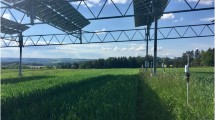Abstract
Genetic variation in ratoon growth and cane yieldafter mechanical harvesting under wet conditions wasexamined among 26 sugarcane clones of diverse geneticbackground, including materials closely related toSaccharum spontaneum and some commercialcultivars. The clones were evaluated under a controltreatment (harvesting under dry conditions andallowing the cane to ratoon without furtherdisturbance), and a traffic treatment (sprayirrigation and then driving heavy field equipment overthe cane stubble immediately after harvesting). Averaged over all clones, the traffic treatment had alarge adverse effect on early growth and final ratoonyield. There was significant genotype × treatmentinteraction for early growth and canopy development,but not for final cane yield. There was also a highgenetic correlation between genetic performance underthe different treatments, indicating that selectionfor ratooning after dry harvesting conditions would bealso effective for improving performance after wetharvesting conditions. A sugarcane breeding programspecifically targeting better ratoon performance underwet conditions would be difficult to justify.
Similar content being viewed by others
References
Berding, N. & B.T. Roach, 1987. Germplasm collection, maintainence and use. pp. 143-210. In: D.J. Heinz (Ed), Sugarcane improvement through breeding. (Elsevier).
Braunack, M.V, A.W. Wood, R.G. Dick & J.M. Gilmour, 1993. The extent of soil compaction in sugarcane soils and a technique to minimise it. Sugar Cane 1993: 12-18.
Braunack, M.V. & T.C. Peatey, 1997. Changes in soil physical properties after one pass of a sugarcane haulout unit. Australian Journal of Experimental Agriculture (in press).
Jackson, P.A. & D.M. Hogarth, 1992. Genotype x environment interactions in sugarcane. I. Patterns of response across sites and crop-years in North Queensland. Aust J Agric Res 43: 1447-1459.
Jackson, P.A. & B.T. Roach, 1992. Performance of sugar-cane progeny from crosses between clones derived from diverse S. spontaneum sources. Trop Agric 1: 57-61.
Mirzawan, P.D.N., M. Cooper & D.M. Hogarth, 1993. The magnitude of genotype by environment interactions for cane yield, sugar yield and CCS in southern Queensland and their impact on selection. In 'Focused Plant Improvement: Towards Responsible and Sustainable Agriculture. Proceedings of the Tenth Australian Plant Breeding Conference, April 1993. (Organising Committee, Australian Convention and Travel Service: Canberra) 1: 57-61.
Swinford, J.M. & T.M.C. Boevey, 1984. The effects of soil compaction due to infield transport on ratoon cane yields and soil physical characteristics. Proc Sth Afr Sugar Tech Ass 58: 198-203.
Roach, B.T. 1989. Origin and improvement of the genetic base of sugarcane. Proc Aust Soc Sugar Cane Tech 1989 conf pp. 34-48.
Torres, J.S. & F. Villegas, 1993. Differentiation of soil compaction and cane stool damage. Sugar Cane 1993 No. 1: 7-11.
Wilson, P.R. & D.E. Baker, 1990. Soils and agricultural suitability of the wet tropical coast of North Queensland: Ingham area. Land Resource Bulletin QV9001. Queensland Department of Primary Industries, Brisbane.
Author information
Authors and Affiliations
Rights and permissions
About this article
Cite this article
Jackson, P., Braunack, M., Foreman, J. et al. Genetic variation in sugarcane for ratooning after harvester damage in wet soil. Euphytica 111, 1–8 (2000). https://doi.org/10.1023/A:1003656226314
Issue Date:
DOI: https://doi.org/10.1023/A:1003656226314




